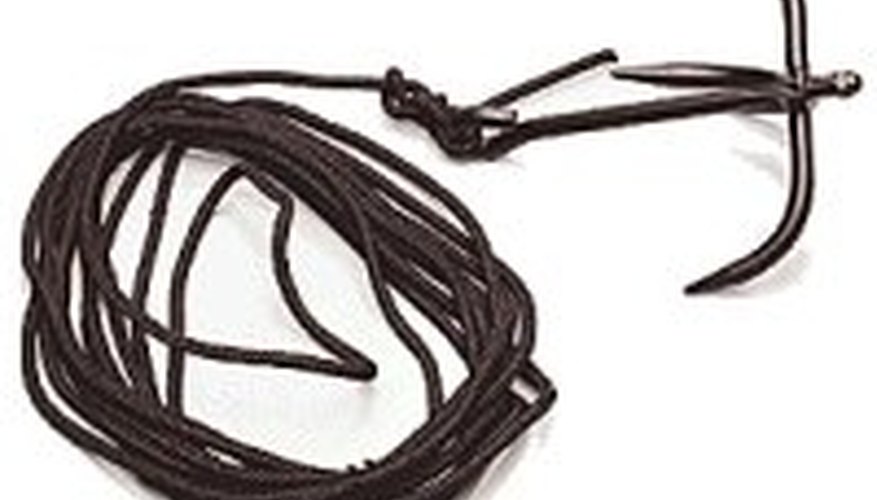
Grappling hooks have been used for years, originally in naval warfare. They were used to latch onto enemy ships for boarding. Grappling hooks have since maintained their military usefulness, but have also shown up in several fictional stories, increasing their popularity. Characters from Link (in tThe Legend of Zelda) to Batman have all used grappling hooks in their adventures to save the world. Many people would love to learn to use a grappling hook (sometimes based solely on their use in fictional works), but many probably assume it would be too much of a hassle. Luckily, following a few simple steps can have anyone scaling walls with his own grappling hook in no time.
Select a grappling hook for your specific needs. A collapsible grappling hook is ideal, as it will be easier to carry around. A light hook is also helpful, as you can throw it further. Do not go the cheap route when buying your hook. Make sure the hook is durable and can support at least twice your body weight. It is better to spend the few extra dollars now than to pay for a trip to the emergency room.
Stand close to whatever structure you intend to scale. You should never scale something that will get you in trouble--but if you are, standing closer to the structure will decrease your chances of being seen. Standing close to the structure also means you won't have to spool out or use as much rope.
Pick out the point to which you will be trying to attach the grappling hook. Your point can be a building ledge, statue, fire escape, flag pole, parapet or anything else the hook can firmly lock onto. The point should be a heavy-looking, fixed object the hook can wrap around (such as a statue) or a secure point the hook can "bite" into (such as a building ledge or flag pole). The point you intend on hooking to should look strong enough to hold your weight.
Estimate the amount of rope, or line, you will need to reach that specific point. If you do not use enough rope, the hook will never make it to its intended target, and will fall back to the ground. After estimating the amount of rope you need, loosely wrap the necessary line into loose coils and hold it slack in the hand you are not using to throw the hook.
Throw the grappling hook. If your target isn't high (i.e., it's on the first or second floor), you can use an underhand throw. Just hold the hook by its metal base near the rope and throw it like a softball, but in an upward trajectory towards your target. If the target is higher, an overhand throw will probably be more useful. Once again grip the hook by the metal base, as close to the rope as possible. This will minimize the danger of the hook catching your hand. If the target is especially high, you may have to swing the hook by the rope. Swing the hook like a lasso. The farther away your target is, the more line you should use to swing the hook. You should also swing the hook faster for higher distances.
Release the hook (or rope if you had to swing) toward your target. Do not firmly grasp the loops of line in your non-throwing hand. Just allow the line to come out of your hand with the force of the grappling hook.
Pull down on the rope to ensure the hook is secure once it reaches its target. Pull on the rope with a steady, firm grip to ensure the hook won't come loose. Put as much of your weight as you can on the rope while pulling on it, to ensure that the hook and whatever it is hooked to will hold your weight as you ascend. Tie part of the rope to your body to assure your safety if you lose your grip. Begin ascending the structure.
Untie the rope from your body and unhook your grappling hook from its target once you reach safety. Coil the rope, then pack up the line and grappling hook.
Warnings
- Avoid scaling public structures unless you have permission.
- Remember that scaling large structures is hazardous; take every precaution to ensure your safety. Mattresses or a pile of cardboard boxes will reduce or eliminate the risk of injury from falling.
Tips
- Practice your aim as much as possible before attempting to scale a structure. You do not want to spend an hour trying to hook onto a target when you actually have to scale a structure.
Tips
- Practice your aim as much as possible before attempting to scale a structure. You do not want to spend an hour trying to hook onto a target when you actually have to scale a structure.
Warnings
- Avoid scaling public structures unless you have permission.
- Remember that scaling large structures is hazardous; take every precaution to ensure your safety. Mattresses or a pile of cardboard boxes will reduce or eliminate the risk of injury from falling.
Writer Bio
Curtis Fease started writing professionally in 2007. He has a dual bachelor's degree in psychology and criminal justice from Augusta State University.



